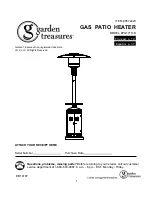
26
331432-001
Important Notes and Warnings
•
This heater is certi
fi
ed to be installed using PVC,
CPVC, or polypropylene plastic vent material. Only
use approved material. All venting material and
components must be joined with the approved primer/
cleaner and solvent cement or mechanical seals (see
“Polypropylene Vent Systems”).
•
Do not common vent this heater with any other
appliance.
•
During operation the plastic piping will expand as it
heats up and contract as it cools down. This is normal
for this type of venting. Rigidly fastening the vent piping
can cause undue stress that may result in the cracking
or fracturing the vent piping material. A fracture of the
venting pipe may pose a serious safety hazard. To
prevent stressing of the vent system, all hangers and
supports must allow the vent piping freedom to move.
•
Use long sweep elbows wherever possible. Closely-
coupled elbows and short radius elbows can reduce
the venting capacity.
•
All power vented water heaters generate a certain
amount of operational noise. In order to minimize noise
transmission to the support structure, use isolation pads
between the pipe hangers and the vent pipe.
•
Most power vent installations develop some
condensation in the vent piping. When using long runs
of venting or when the venting passes through cold or
unheated areas, considerable amounts of condensate
from the
fl
ue gases can develop. Provision must be
made for the condensate to drain freely from the
system or to be collected in a condensate trap(s) that
can be drained. Damage or fracture of the vent piping
may occur if the condensate is allowed to collect and
freeze. Pooling of condensate can restrict air
fl
ow and
can cause nuisance failures of the system.
Venting terminations and sizing
•
Heaters are supplied with a 3”x3” rubber coupling to
attach the venting to the blower and a 3”, 45° vent
termination elbow.
•
Supplied with this heater are several vent termination
screens (see Figure 26).
Installed in the vent termination elbow, the vent screen
is required to keep foreign objects, rodents and small
birds from entering the venting system. These screens
have been sized to ensure maximum energy ef
fi
ciency of
the vent system based on the “equivalent length” of the
vent piping. CHOOSE ONLY the ONE SCREEN THAT
MATCHES YOUR VENTING CONFIGURATION (see
Figure 26). How to determine the “equivalent length” is
shown in Figure 28 and in Table 2.
Vent screen installation
•
Install the appropriate vent screen into the vent
termination elbow.
•
Gently push the screen into the termination elbow until
it sits against the inside shoulder.
•
The metal wire screens are self-securing.
•
Plastic screens must be secured with (2) screws:
1. Install plastic screen into elbow (see Figure 27).
2. Orient screen as shown in see Figure 27 with an
opening at the bottom of the assembly and the
smooth side facing in.
3. Ensure screen is fully seated against shoulder in
elbow.
4. Secure screen in place with screws (
fi
eld supplied)
(see Figure 27).
with 4 in. venting
VENT LENGTH GREATER THAN
15.2 EQUIVALENT METRES
(50 EQUIVALENT FT.) USE THIS
SCREEN (SUPPLIED).
with 3 in. venting (short)
with 3 in. venting (long)
VENT LENGTH LESS THAN OR
EQUAL TO 6 EQUIVALENT METRES
(20 EQUIVALENT FT.)
USE THIS SCREEN (SUPPLIED).
VENT LENGTH GREATER THAN
6 EQUIVALENT METRES
(20 EQUIVALENT FT.)
USE THIS SCREEN (SUPPLIED).
Figure 26
#6 SHEET
METAL
SCREW
ELBOW
#6 SHEET
METAL
SCREW
(FIELD
SUPPLIED)
PLASTIC
SCREEN
SHOULDER
OPEN
CLOSED
POCKETS
FACING OUT
Figure 27
















































